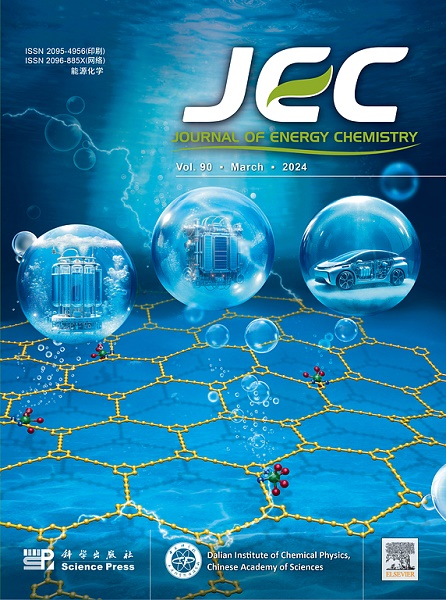Aqueous dual ionic/electronic conducting binder enabling water-scarce, Zn2+-enriched interface for aqueous zinc metal batteries
IF 13.1
1区 化学
Q1 Energy
引用次数: 0
Abstract
The development of aqueous zinc-ion batteries is crucial for advancing sustainable energy storage technologies. However, their widespread application is hindered by Zn corrosion and uncontrolled Zn dendrite growth. One promising approach involves creating a functional organic-inorganic interface on the Zn surface. Traditional binders, such as polyvinylidene fluoride (PVDF), fail to regulate water activity and ion migration, limiting the effectiveness of the interface. Herein, we introduce an aqueous dual ionic/electronic conducting binder, poly(3,4-ethylenedioxythiophene): polystyrene sulfonate (PEDOT:PSS), to build a water-scarce, Zn2+-enriched interface. Our findings demonstrate that PEDOT:PSS not only facilitates uniform distribution of inorganic fillers, forming a cohesive and compact interface, but also significantly enhances mechanical integrity. Additionally, the sulfonate groups within the binder matrix disrupt the hydrogen bond network of water molecules, reducing water activity and lowering the desolvation energy barrier of Zn(H2O)62+ clusters. Therefore, the transference number of Zn2+ is elevated to 0.81 (compared to 0.61 with PVDF), mitigating undesirable side reactions and enabling dendrite-less Zn deposition. Consequently, symmetrical Zn||Zn cells with PEDOT:PSS binder demonstrate a lifetime with 4.2 times longer than those with PVDF. This work underscores the critical role of binder chemistry in stabilizing metal anodes for aqueous batteries.

水相双离子/电子导电粘结剂使水相锌金属电池的富Zn2+界面缺水
水性锌离子电池的发展对于推进可持续储能技术至关重要。然而,锌的腐蚀和锌枝晶生长不受控制阻碍了它们的广泛应用。一种很有前途的方法是在锌表面创建一个功能性的有机-无机界面。传统的粘合剂,如聚偏氟乙烯(PVDF),不能调节水活性和离子迁移,限制了界面的有效性。在此,我们引入了一种双离子/电子导电水性粘合剂,聚(3,4-乙烯二氧噻吩):聚苯乙烯磺酸盐(PEDOT:PSS),以建立一个缺水,富Zn2+的界面。研究结果表明,PEDOT:PSS不仅促进了无机填料的均匀分布,形成了粘性和致密的界面,而且显著提高了机械完整性。此外,结合剂基体中的磺酸基破坏了水分子的氢键网络,降低了水的活度,降低了Zn(H2O)62+簇的脱溶能垒。因此,Zn2+的转移数提高到0.81 (PVDF的转移数为0.61),减轻了不良副反应,并使无枝晶Zn沉积成为可能。因此,具有PEDOT:PSS粘结剂的对称Zn||锌电池的寿命比具有PVDF的电池长4.2倍。这项工作强调了粘合剂化学在稳定水性电池金属阳极中的关键作用。
本文章由计算机程序翻译,如有差异,请以英文原文为准。
求助全文
约1分钟内获得全文
求助全文
来源期刊

Journal of Energy Chemistry
CHEMISTRY, APPLIED-CHEMISTRY, PHYSICAL
CiteScore
19.10
自引率
8.40%
发文量
3631
审稿时长
15 days
期刊介绍:
The Journal of Energy Chemistry, the official publication of Science Press and the Dalian Institute of Chemical Physics, Chinese Academy of Sciences, serves as a platform for reporting creative research and innovative applications in energy chemistry. It mainly reports on creative researches and innovative applications of chemical conversions of fossil energy, carbon dioxide, electrochemical energy and hydrogen energy, as well as the conversions of biomass and solar energy related with chemical issues to promote academic exchanges in the field of energy chemistry and to accelerate the exploration, research and development of energy science and technologies.
This journal focuses on original research papers covering various topics within energy chemistry worldwide, including:
Optimized utilization of fossil energy
Hydrogen energy
Conversion and storage of electrochemical energy
Capture, storage, and chemical conversion of carbon dioxide
Materials and nanotechnologies for energy conversion and storage
Chemistry in biomass conversion
Chemistry in the utilization of solar energy
 求助内容:
求助内容: 应助结果提醒方式:
应助结果提醒方式:


